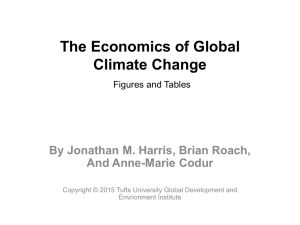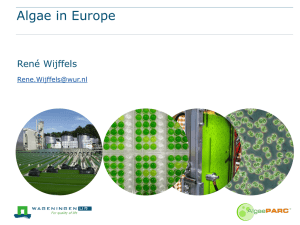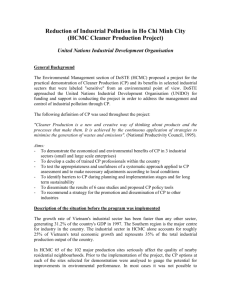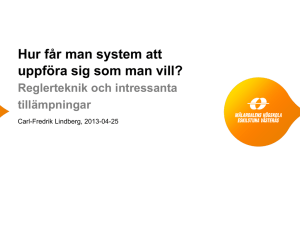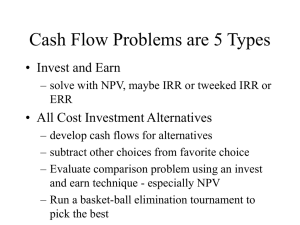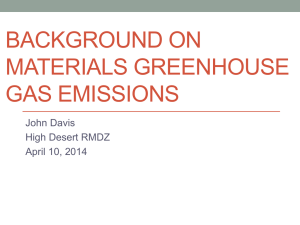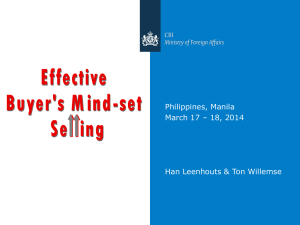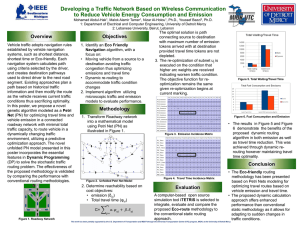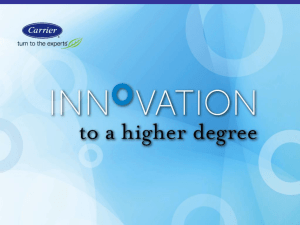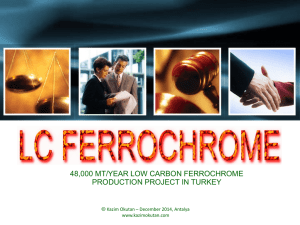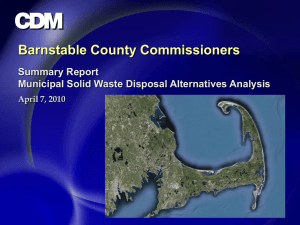Energy - UNIDO
advertisement
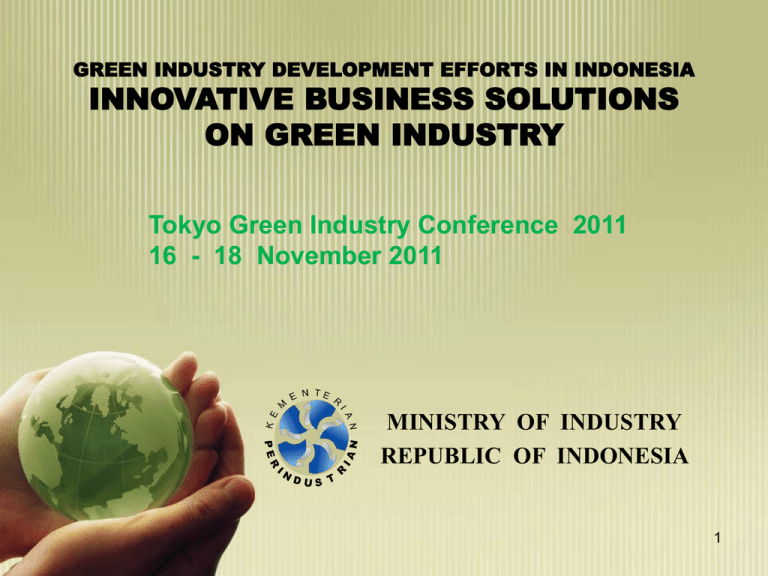
GREEN INDUSTRY DEVELOPMENT EFFORTS IN INDONESIA INNOVATIVE BUSINESS SOLUTIONS ON GREEN INDUSTRY Tokyo Green Industry Conference 2011 16 - 18 November 2011 MINISTRY OF INDUSTRY REPUBLIC OF INDONESIA 1 OUTLINE I. II. III. IV. Background Green Industry Concept Energy Conservation Program Government Bisnis Model Green Industry Development V. Green Industry Development Chalenges VI . Closing 2 I. BACKGROUND 1. Current Industrial Condition • Industrial development in Indonesia has been running for 50 years. Besides giving positive contribution to the country, it also result in environmental problem especially pollution due to industrial waste and inefficient use of natural resources. • Due to limitation of natural resources availability, energy crisis, and drop of environmental carrying capacity, the development of eco-friendly industry or as known as green industry is a must. 3 2. Global Market Trend • Trade liberalization, resulting in the decrease of trade-related tariff (or even none). • Implementation of non-tariff policies, such as cleaner production and eco-product standards, Renewal Energy Directive (RED) and REACH have become a constraint for Indonesian products export, especially to enter European and American countries. • Global market trend towards eco-product is a chance that should be anticipated as well as gained for benefits. • To compete in global market eco-friendly industry or green industry development which able to create eco-products is a must. 4 3. Government’s Commitment to Reduce Greenhouse Gases Emission President’s Commitment at G-20 Pittsburgh and COP15 Reducing greenhou gases emission in 2020 26% 26% Self-initiatives/ funding 41% 15% Selfinitiatives plus international support/ funding Nat. Action Plan on GHG 5 Indonesia total Greenhouse Gases (GHG) emission from all sectors in 2000: 1,377,982.95 Gg CO2e GHG Contributors : 1. Land use change & forestry 59.6% 2. Energy 20.4% 3. Waste11.42% 4. Industry 3.12% 5. Agriculture 5.47% GHG Contributors (Industrial sector only): 1. 2. 3. 4. 5. 6. 7. 8. 20.4 % 3.12 % 59.6% 5.47 % 11.42 % Source: SECOND NATIONAL COMMUNICATION-SNC, NOV 2010 Cement Metal and Steel Textile Pulp and paper Petrochemical Fertilizer Glass and ceramics Food and beverages 6 4. Industrial Development Policy Long-Term Industrial Development - National Goal (President’s Decree No. 28 Year 2008 about National Industrial Policy) Developing industries with Sustainable development concept Economy Development of industries which capable of continuously producing goods as demanded by market. Environment Development of industries which capable of maintaining ecosystem balance, sustainable use of natural resources, and prevent natural resources exploitation as well as carry out environmental preservation function. Social Development of industries which deliver social contribution such as creating job vacancies, better education, health, and security. 7 II. Green Industry Concept Business as Usual Packaging Technology/ Equipment Supplier Raw and additional material Product Production Process Waste/ Emission Green Industry Energy Eco Friendly • Eco-friendly • Efficient and effective • Renewable (if available Products and packaging leftovers • 3R implementation (Reduce, Reuse, Recycle,) • Environmentally conscious human resources • SOP Application • Efficient and effective Factory layout • Equipment modification • Eco-Product • Eco-Packaging • Low/ zero emission • Proper treatment based on standards • Non hazardous • Reusable (inside/outside process) Eco Friendly Green Production SUPPORTING •Standards •Certification Body •Cooperation • Funding •Incentive •Education and training •R & D • Technical Assistance • Information 8 System III. Energy Conservation Program Industry is the highest energy consumers Energy Usage (Million BOE) Transportation Oil 314.1 (50,0%) 32,6% Gas 79,2 (12,6%) Coal 145,1 (23,1%) LPG 11,4 Energy Source Industry 47,2% (1,8%) Electricity 79.1 (12,6%) Total 628,8 Oil share is still very dominant Household & Comercial 20,2% Source: Ministry of Energy and Mineral 9 Resources, 2008 Grand Strategy of Energy Conservation and CO2 Emission Reduction in Industrial Sector 2010 - 2020 10 Energy Conservation Implementation Stages and CO2 Emission Reduction in Industrial Sector (2010 -2020) 1. Phase 1 : Implementation of Energy Conservation and CO2 Emission Reduction in Industrial Sector; 2. Phase 2 : Promotion of CO2 emission reduction through several pilot project in energy voracious industries such as steel, pulp and paper industries; 3. Phase 3: Establishment of Energy Services Company (ESCO) 4. Phase 4 : Eco-Label Implementation Since 2010, assistances in energy conservation implementation have been conducted at 35 steel industries and 15 pulp & paper industries. 11 IV. Government Bisnis Model Green Industry Development 1. Pilot Project Machinery Restructurization in Textile Industry PT. Daliatex-Bandung / Water and Energy (NEDO support – 2007 ) a. Dyeing Unit No Utility Energy and Water Usage Before Changing The Machine Energy and Water Usage After Changing The Machine 1. Electricity 6,757 MJ/Ton 1,9316 MJ/ton 2. Steam 12,230 MJ/Ton 6,978 MJ/ton Total Energy 100% 47% Total Water 112 ton/ton 68,9 ton/ton 100% 61.6% 3 Efficiency (%) 53% 38,3 12 b. Tenter Unit (Drying and Color Fixation) No. Utility Energy usage before applying cleaner production Energy usage after applying cleaner production 1. Electricity 1,395 MJ/Ton 1,257 MJ/ton 2. Heat (Steam) 8,632 MJ/Ton 4,579 MJ/ton Total Energy 100% 58,25 Efficiency (%) 41,75 13 c. Dryer Unit No. Utility Energy usage before applying cleaner production Energy usage after applying cleaner production 1. Electricity 3,083 MJ/Ton 2,302 MJ/ton 2. Heat (Steam) 7,730 MJ/Ton 2,446 MJ/ton Total Energy 100% 55 % Efficiency (%) 45 % Conclusion: With NEDO support, efficiency achieved at PT. Daliatex: •Energy : 52% 1. Industry become •Water : 38% more efficient • 2. Eco-friendly •Chemicals : 20-25% 14 2. Restructurization Program for Textile and Textile Products, Footwear, and Sugar Industries a. Background Approximately 80% machinery used in those industries aged more than 20 years and consumed a lot of resources (water and energy), non-environmental friendly. Low efficiency, unpunctual delivery time Low competitiveness Flooding of Imported products 15 b. Objective: Giving stimulus (grant) for machine renewal in order to raise the competitiveness and environmental preservation. c. Form of Grant: Granting 10% of investment cost support with the maximum amount of 5 billion Rupiahs/company/budget year. 15 % cost reduction for local machinery products purchasing, proved by the calculation of machinery’s local contents. 16 d. Realization of Machinery Restucturization Program Impact of the Program: Textile and Textile Products 619 companies Sugar Footwear 78 companies 50 companies (2009-2010) (2009 - 2010) •Increasing production capacity: 1,52% •Increasing grinding effectiveness: 1,2% •Increasing steam efficiency: 0,09% •Increasing energy efficiency: 22-25 % •Increasing production capacity: 29,75% •Increasing productivity: 5,46% •Increasing job employment: 21.700 people. (2007 - 2010) •Increasing energy saving: 6-18% •Increasing productivity: 7-17 % •Increasing production: 15-28 % •Increasing job employment : 55.000 people 17 3. CO2 Emission Reduction Program in Industrial Sector a. CO2 emission inventory in 8 industrial sectors, i.e. cement, steel, pulp & paper, petrochemical, fertilizer, ceramic, textile, food and beverage; b. Formulation of CO2 emission reduction roadmap for cement industry. 18 4. Technical Assistance in Cleaner Production: Technical assistance in identifying chances of efficiency enhancement, conducting analysis and evaluation of economical, technical, and environmental feasibility. Technical Assistance had been given to: 1.Food Industry (PT Niramas – Bekasi); 2.Coating Industry (PT Hempel – Bekasi); 3.Fish Canning Industry (PT Avila Prima – Banyuwangi); 4.Cosmetics Industry (PT Sparindo – Tangerang); 5.Electroplating Industry (PT Citra Inti – Tangerang) According to cleaner production result, industries can optimize the use of resources (energy, water, and raw material) to be more efficient and eco-friendly. 19 Result: Cleaner Production Recomendation No. Industry Potential Savings (Rp/year) Investment Cost (Rp) 1,858,032,005 559,490,540 Source of Savings 1. Food Efficient use of water, plastics, and flour 2. Coating 976,388,204 11,900,000 Efficient use of packaging and solvent 3. Fish Canning 977,500,614 119,053,750 Efficient use of Water, energy, packaging and rejected products 4. Cosmetics 188,069,845 8,010,000 Efficient use of raw materials, alcohol, water, and energy. 5. Electroplating 147,502,000 12,647,000 Efficient use B3 (NiSO4, Ni Cl2, CrO3, BO3, H2SO4), water and energy 20 Electroplating Industry (PT Citra Inti - Tangerang ), cont’d… Unit Operation Cleaner Production Actions Benefit Investment Cost (Rp) Potential savings (Rp/year) NickelChromium Coating Installing additional anode in chromium tank Minimization of waste due to less rejected products 3,000,000 * Zinc Coating Insulating heating tubs Reduce heat loss 1,197,000 - 21 IV . GREEN INDUSTRY DEVELOPMENT CHALLENGES 1. Needs of machinery renewal/equipment modification. Investment is needed in order to renew/modify the equipments. In the other hand, bank interest is high (14 %) and there’s no existing domestic machinery industries. 2. Reward for industrial practitioners who have implemented green industry, such as funding, technical assistance, etc. to support continuous improvement. 3. Appropriate green industry incentive formulation. 22 VI. CLOSING Establishment and development of Green Industry need a lot of support from all stakeholders and national or international related institutions. To achieve the goal – green industry implementation, Indonesia needs good cooperation from other countries through regional or international forums and international organization. THANK YOU 23
